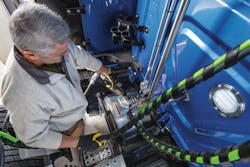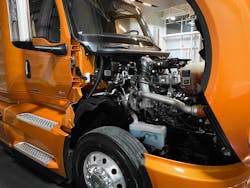Industry reacts to EPA’s truck, engine emissions proposal
Flexibility. Consistency. Feasible implementation. Not disruptive to the economy or supply chains.
Those are just a handful of priorities on the trucking industry’s must-haves list in response to the U.S. Environmental Protection Agency’s (EPA) proposed heavy-duty truck and engine standards rule. The industry, which had more than two months to mull EPA’s latest proposals, filed more than 600 new comments in the Federal Register by an extended May 16 deadline.
Ultimately, those who commented can agree that clean air is a priority for everyone. Consensus, however, is that environmental outcomes could worsen if EPA sets options that are too stringent or limiting for proper compliance.
By December 2022, EPA is proposing new, stronger standards for heavy-duty vehicles and engines starting in model year (MY) 2027. The proposed standards, entitled Control of Air Pollution from New Motor Vehicles: Heavy-Duty Engine and Vehicle Standards, would reduce emissions of nitrogen oxides (NOx) and set updated greenhouse gas (GHG) requirements for certain commercial vehicle categories.
See also: EPA proposes new truck emissions standards
EPA’s latest proposal offers two options:
- Option 1: A two-step approach to achieve 90% reduction in NOx emissions by 2031 (cutting NOx emissions from 0.2 to 0.035 by 2027 and from 0.035 to .02 by 2031).
- Option 2: A single-step, 75% reduction in remaining NOx emissions (from 0.2 to .05) by 2027.
Overall, the proposals are the first step in EPA’s Clean Trucks Plan—a series of clean-air and climate regulations that the agency will develop over the next three years to reduce pollution from trucks and buses.
In a separate action, but still part of the Clean Trucks Plan, EPA will set new GHG emissions standards for heavy-duty vehicles as soon as MY 2030. This action will more comprehensively address the long-term trend toward zero-emission vehicles across the heavy-duty sector, the agency stated.
Some, however, oppose reopening those GHG standards.
“Our industry is a long lead-cycle and capital-intensive business that depends on certainty with rulemaking,” Sean Waters, Daimler Truck North America’s (DTNA) VP of product compliance and regulatory affairs, told FleetOwner via email. “We’ve spent a large number of years preparing for the technical hurdles of the 2027 GHG standards, and EPA’s proposals put that development at risk.”Waters also stressed that federal GHG rules shouldn’t change from administration to administration.
“DTNA and all of the industry advocated strongly against the last administration weakening the standards under that same principle, and we’re doing the same as this administration seeks to undue the certainty on which business depends,” Waters said.
Jacqueline Gelb, Navistar’s VP of government affairs, told FleetOwner that Navistar supports the regulatory goals established under the GHG 2 program in 2016 and is committed to keeping those milestones in place.
See also: EPA finalizes GHG Phase 2
“We believe that GHG 3 should be focused on setting the regulatory framework and standards to drive towards a zero-emission future in a larger ‘well-to-wheel’ structure that incorporates all technology pathways,” Gelb said. “Market availability of zero-emission vehicles, adoption rates, and buildout of alternative fueling and charging infrastructure should serve as guideposts for a GHG 3 regulation.”
Manufacturers weigh in on EPA's proposed options
On May 16, the Truck and Engine Manufacturers Association (EMA) released an executive overview stressing that a finalized NOx rule from EPA must be a single-step program with one set of new standards, rather than a multistep approach with increasingly rigid requirements.
“The pending rulemaking needs to be truly cost-effective to ensure that the market is fully receptive to the new low-NOx vehicles,” according to EMA. “Otherwise, fleet turnover will be stalled or delayed, which will diminish the envisioned benefits of the low-NOx regulations. Fashioning a final rule that will not impede fleet turnover will help to ensure that the reasonably estimated benefits from this rulemaking can be achieved.”
EMA added that OEMs will not be able to commit to building Option 1-compliant diesel engines under EPA’s current proposal.
By finalizing Option 1, EMA stated that EPA will, in effect, prohibit heavy-duty on-highway (HDOH) diesel engines as of 2027. “That would have enormous ramifications for the economy and security of this country,” EMA urged.
That option, for instance, would impose an estimated $35,000 per truck due to primarily to the extended emission warranty and useful life provisions, according to EMA. In turn, that could cause fleets to run their older, higher-emitting trucks longer.
See also: 'Clean' trucking is here to stay
The first proposed option also could delay progress on zero-emission vehicles (ZEVs) by forcing manufacturers to divert resources from further development of ZEVs.
“Our industry is focused on the shift to zero-emission vehicles,” DTNA’s Waters said, adding that DTNA’s goal is to offer only carbon-neutral vehicles by 2039. “Future rules should focus on enabling this transition, rather than squeezing diminishing returns from conventional vehicles."
In its comments, EMA has tasked the EPA to focus on Option 2—with modifications to help reduce the risk for manufacturers. Both options will require new low load standards, and more frequent and stringent in-use testing, EMA added.
“We strongly support EPA’s goal of significantly decreasing emissions from heavy-duty engines,” John Mies, SVP of corporate communications at Volvo Trucks North America (VTNA), told FleetOwner. “We’re hopeful that EPA will carefully consider industry input and develop a final regulation that is stringent enough to improve air quality, without creating unintended consequences that could postpone market adoption of cleaner technology vehicles.”
Allison Transmission, which manufactures fully automatic transmissions for medium- and heavy-duty commercial vehicles, noted that as EPA proceeds to finalize its rule, the agency should "retain flexible compliance mechanisms” that account for different vehicle types and applications.
Similarly, Navistar’s Gelb added that all components of the rule need to be balanced, cost effective, and not severely disrupt the truck market.“Option 2 provides a framework for the industry to work closely with EPA to develop a rule that will be acceptable to our customers and will allow for older, higher-emissions vehicles to be replaced with cleaner technology,” Gelb said.
Gelb maintained that GHG 2 “should remain intact to provide regulatory certainty for products currently being developed that already have years of committed technology investment.”
“In our estimation, neither proposed change is feasible as written, and EPA has yet to demonstrate otherwise,” DTNA’s Waters explained. “We believe that, given significant modifications, Option 2 is a reasonable starting place from which to develop a feasible, cost-effective rule that guarantees the maximum technology available to reduce NOx emissions, but does so in a way that manufacturers can achieve, and balances the need to prioritize the development of new ZEV technologies.”
“We also believe EPA could use its authority and influence to help remove older, higher-polluting trucks from the road,” Waters added. “Fully half of the fleet on the road today is more than 20 years old. Removing them from the road could make a much bigger improvement to fleet emissions than cleaning up the last 1-2% of emissions from new, clean trucks.”
Trucking groups react
The Owner-Operator Independent Drivers Association (OOIDA), which represents more than 150,000 small business truckers and independent professional drivers, views the regulatory options presented in EPA's proposal as impractical for small trucking businesses.
“Clean air is a priority for everyone, including truckers, but the technology used in heavy-duty trucks to improve air quality has to be affordable and reliable,” OOIDA stressed. “Small-business truckers and owner-operators should not be used as trial cases for testing new technology, while getting priced out of business in the process. Unfortunately, each of the proposed timelines to achieve nitrogen oxides (NOx) emissions reductions leave us wondering if the same mistakes from previous rulemakings will be repeated. Furthermore, OOIDA disagrees with EPA’s certification that this action will not have a significant economic impact on a substantial number of small business entities under the Regulatory Flexibility Act.”
See also: Survey points to exodus of small carriers
OOIDA has urged the EPA to consider “a more feasible implementation timeline” and to continue seeking out feedback from owner-operators and smaller trucking companies as the agency develops any final rule.
“Truckers know all too well that poorly implemented regulations will result in breakdowns, downtime, and ultimately set back the goal of achieving cleaner air,” OOIDA added.
The Truckload Carriers Association (TCA), which advocates that the trucking industry continue to work to reduce greenhouse gas emissions, expressed its disappointment in the EPA’s proposed standards. In public comments on the Federal Register, TCA President Jim Ward maintained that the measure does not “fully appreciate” market and technology constraints within the industry.
“TCA believes the regulations would limit equipment options for carriers, as well as worsen environmental outcomes in the long run by applying unmanageable pressure on pricing and disincentivizing fleet turnover,” Ward stated.
TCA added that the proposed standards would require considerable expenditure by motor carriers to invest in newer-model vehicles and engines.
Likewise, the Rhode Island Trucking Association (RITA) filed comments in support of “a single national low-NOx rule that is technologically feasible, protects American jobs, and is not disruptive to the nation's economy or supply chains.”
RITA agreed with many commenters that an approach such as Option 1 cannot be achieved by all classes of trucks and would cause “significant uncertainty” among fleets, resulting in fleets purchasing new trucks before new standards are implemented.
“This pre-buy/low-buy/no-buy scenario would jeopardize thousands of good-paying jobs and slow environmental success,” RITA stated.
About the Author

Cristina Commendatore
Cristina Commendatore is a past FleetOwner editor-in-chief. She wrote for the publication from 2015 to 2023.


